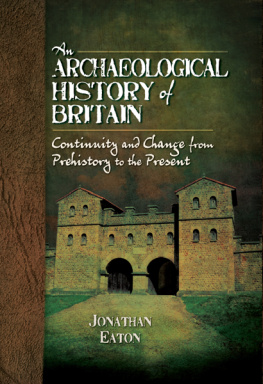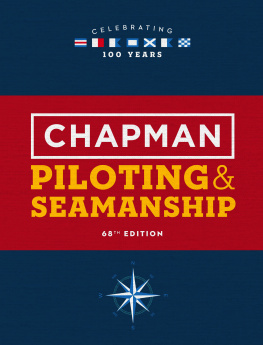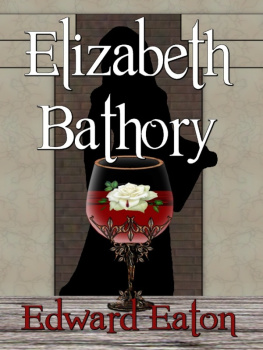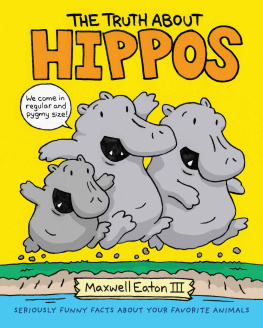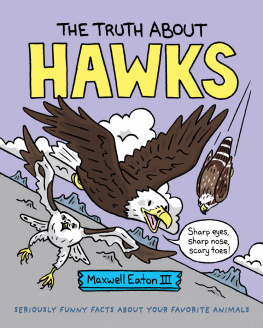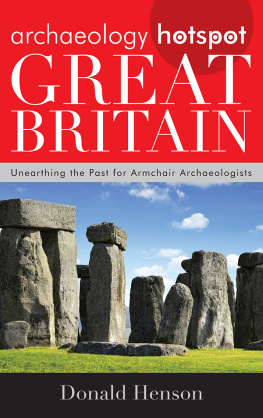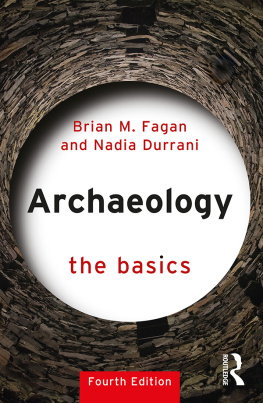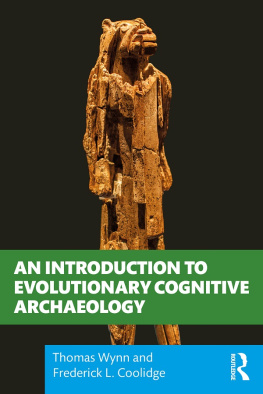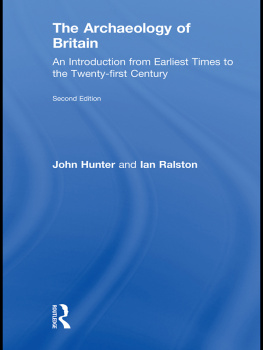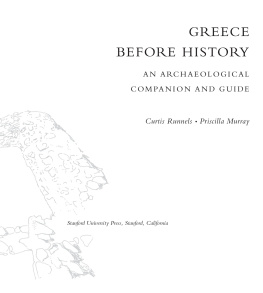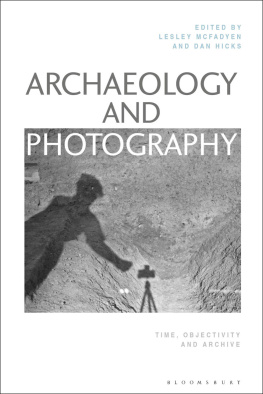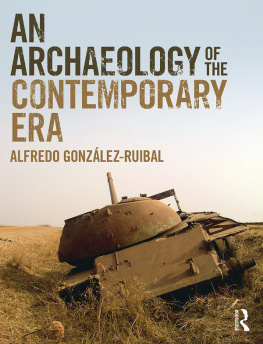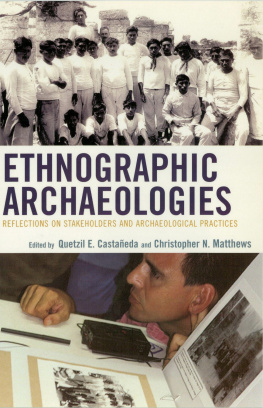First published in Great Britain in 2014 by
PEN & SWORD ARCHAEOLOGY
an imprint of
Pen and Sword Books Ltd
47 Church Street
Barnsley
South Yorkshire S70 2AS
Copyright Jonathan Eaton, 2014
ISBN: 978 1 78159 326 4
EPUB ISBN: 978 1 47385 103 0
PRC ISBN: 978 1 47385 119 1
The right of Jonathan Eaton to be identified as the
author of work has been asserted by him in accordance
with the Copyright, Designs and Patents Act 1988.
A CIP record for this book is available from the British Library
All rights reserved. No part of this book may be reproduced or transmitted
in any formor by any means, electronic or mechanical including photocopying,
recording or by any information storage and retrieval
system, without permission from the Publisher in writing.
Printed and bound in England
by CPI Group (UK) Ltd, Croydon, CR0 4YY
Typeset in Times New Roman by
CHIC GRAPHICS
Pen & Sword Books Ltd incorporates the imprints of
Pen & Sword Archaeology, Atlas, Aviation, Battleground, Discovery,
Family History, History, Maritime, Military, Naval, Politics, Railways,
Select, Social History, Transport, True Crime, and Claymore Press,
Frontline Books, Leo Cooper, Praetorian Press, Remember When,
Seaforth Publishing and Wharncliffe.
For a complete list of Pen and Sword titles please contact
Pen and Sword Books Limited
47 Church Street, Barnsley, South Yorkshire, S70 2AS, England
E-mail:
Website: www.pen-and-sword.co.uk
Contents
Acknowledgements
This book presents an introduction to the archaeological history of Britain for the general and specialist reader alike. It does not attempt to provide a comprehensive overview of the subject, but is instead designed to inspire readers to explore their interests in greater depth. The relevant sources cited in the bibliography will serve as a useful starting point. Where possible I have cited texts which are easily accessible to the general public. The genesis of this work lies in my teaching and I am indebted to my former students for drawing my attention to the need for an introductory text covering all of British archaeological history. Their questions and discussions have shaped this book. Students, colleagues and friends at Newcastle College have stimulated my thinking and provided a congenial environment in which to work. My passion for teaching and communicating the past was inculcated by Derek Slater whose enthusiasm, encouragement and patience remain a constant inspiration to me.
I wish to thank my editors, Eloise Hansen and James Dixon, for their guidance and support in preparing this text for publication. Marcia Pointon kindly provided me with a copy of her article on the funerary topography of Princess Diana at a critical stage of my research.
The unfailing support of my family and friends has nurtured this book throughout its gestation. Jenesta, Jake and Millie have filled my life with happiness and borne my frequent absences with patience and understanding. I hope that someday Jake and Millie will share my love of our past through reading this text. This book is dedicated to my parents. It is in part payment for their love, devotion and guidance over the past thirty years. But most of all, this book is for a Christmas Eve long ago when they stayed up late into the night to make a Roman army costume for a little boy. Optimus parentibus.
Chapter 1
Early Prehistory
(c. 800,000 4200 BC)
Even a cursory inspection of a reasonably detailed map or satellite image of Britain will reveal two seemingly incontrovertible facts. First, Britain is an island nation separated from the European landmass by the English Channel and North Sea. Second, a considerable amount of our landscape is dedicated to agriculture of various kinds. From the viewpoint of traditional history, both of these facts are true. Yet from the longer perspective of archaeological history, Britain has been an island and its inhabitants have practised farming only for a very short space of time. This chapter covers the vast majority of British archaeological history, from the first appearance of archaic humans around 800,000 years ago through to the introduction of farming around 4200 BC. For all of this period, the inhabitants of Britain lived as hunter-gatherers, and, but for a single millennium, Britain was physically connected to the Continent. This era can be characterized as our early prehistory. It is recognized by archaeologists of consisting of two separate periods, the Palaeolithic (or Early Stone Age) and the Mesolithic (or Middle Stone Age). Although these early inhabitants of Britain left only fleeting traces of their presence, they are crucial for understanding the struggles which our ancestors faced in colonising a landmass on the very edge of their ecological range. These were not brutish cavemen, but individuals with potentially complex social structures, hunting behaviour and even, later in this era, belief systems from which certain spiritual beliefs which persist in the modern world may be descended. Ultimately, their story is our story.
British early prehistory can be characterized as the struggle of our species to successfully expand their range in the face of considerable challenges posed by catastrophic climate change. Britain faced a period of dramatic ice ages and warmer interglacial periods which had significant ecological and geographical impacts. It has been calculated that Britain has experienced at least twenty major climatic shifts since the first appearance of archaic humans 800,000 years ago. Indeed, the last ice age only ended around 12,000 years ago. The presence or absence of early humans was dictated by these drastic climactic shifts. For significant periods of time, humans retreated to the Continent to escape extreme conditions, only making fleeting visits back when climatic fluctuations led the glaciers to retreat. Archaeologists estimate that Britain has only been inhabited by humans for around a fifth of the period between 500,000 12,000 years ago.
BEGINNINGS
The archaeological history of Britain begins 800,000 years ago on the coast of what is now Norfolk. At that time, the area around the modern village of Happisburgh was situated near to where a great estuary (the ancestor of the River Thames) flowed into the North Sea. Britain was not yet a separate island, but was instead joined to the continent by a great landmass in the south east, which archaeologists have christened Doggerland. Identifying the presence of humans this far in the past is always difficult. Happisburgh provides the earliest evidence for the presence of archaic humans in Britain. But there is a problem. We do not know who exactly these early inhabitants actually were. They did not belong to the same sub-species as us, as Homo sapiens would not emerge from Africa until several hundred thousand years into the future. Instead, they probably belonged to a closely related group. No physical remains have been found, which means that the exact identity of these hominins is likely to remain a mystery for the foreseeable future.
Nevertheless, it is possible to reconstruct what their environment looked like. The climate was noticeably different than it is today, with warmer summers but cooler winters. The estuary flowed slowly into the North Sea. Pike, sturgeon and other fish species thrived in this environment. The river was flanked by swampy areas which gradually gave way to forest. It is not difficult to understand why archaic humans chose to visit this area. It attracted a range of fauna, whose presence is recorded by the bones they left behind. Mammoth, bison, horses and elk frequented the banks of the river. Smaller mammals such as lemmings and beavers could also be seen. Given the prevalence of prey species, it is unsurprising that predators also lurked in the area. Hyenas and sabre-toothed cats stalked the shallow pools on the fringes of the forest.
Next page
